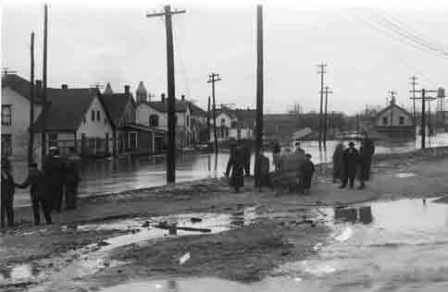by John Beagle
Middletown was originally incorporated in 1833 and has operated under a Home Rule city charter since 1913. The same year as the Great Miami Flood.

What is a home rule charter?
Many americans became interested in reform of the political system in the United States in the late nineteenth and early twentieth centuries. Reformation concerns helped spur the growth of Progressivism, a major reform movement of this era.
In 1912, many Ohioans debated the need for a new state constitution, establishing the Constitutional Convention of 1912. In the end, delegates decided to modify the current constitution through amendments rather than replacing the current document. One amendment dealt with the idea of municipal home rule.
The Home Rule amendment, if passed by the community, would allow Ohio communities with at least five thousand residents to govern themselves, as long as they followed conditions established by the state legislature.
Later that same year, Ohioans voted to approve the municipal home rule amendment. Progressives hoped that passage of the amendment would lead to more participation in the democratic process at the local level, as well as the establishment of more efficient and less corrupt city governments.
After passage of the municipal home rule amendment, a number of Ohio cities created their own city charters. Cleveland was one of the first cities to write a new charter, and was soon followed by Columbus, Dayton, and a number of other cities including Middletown in 1913. Cincinnati's attempt to adopt a charter was unsuccessful at first, although several years later it finally completed the process.
Middletown, as a Home Rule Charter city, is governed by a seven-member City Council, three elected "at large" and four elected "by ward." The Council meets on the first and third Tuesday of the month in the council chamber on the Lower Level of the City Building. The work session begins at 5:30 PM and the Business meeting begins at 6:30 PM.
All elective municipal officers are nominated by a petition of at least fifty (50) of the electors of the City and filed with the board of elections. Nomination petitions for ward candidates are to be signed by at least 50 electors of the represented ward.
The City Council elects a Mayor and Vice Mayor at the first meeting in January at which newly elected members assume their duties of office. Vacancies in the Council are filled by the Council for the remainder of the unexpired term.
The City Council appoints a City Manager, who performs the duties in the City Charter. The City Manager is the Chief Administrative Officer and the head of the administrative branch of the city government. He/she is responsible to the council for the proper administration of all affairs of the city.
The City Council appoints a variety of boards and commissions including the Civil Service Commission, the Park Board, the Board of Health and Environment and many others.

